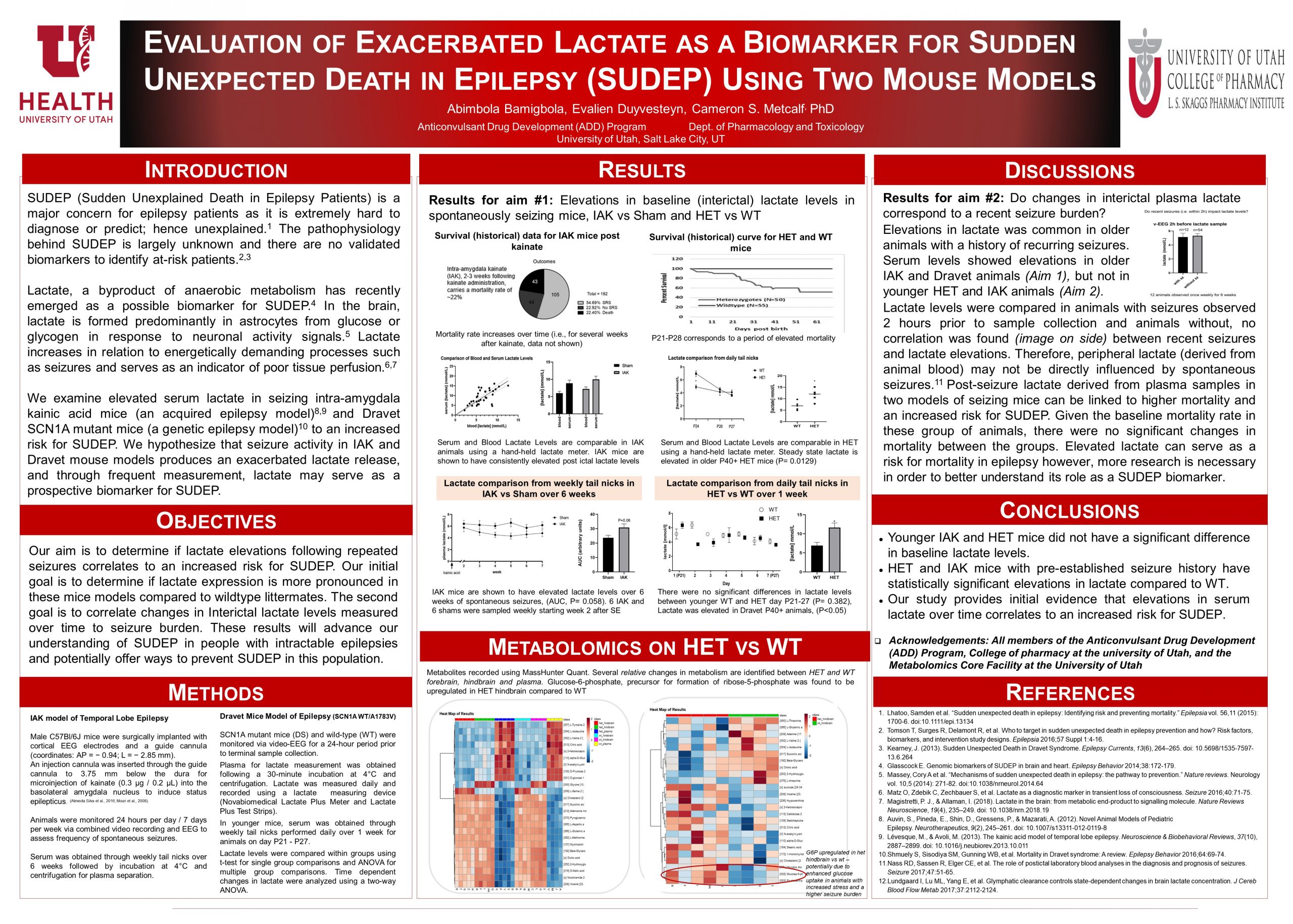Abimbola
Evaluation of Exacerbated Lactate as a Biomarker for Sudden Unexpected Death in Epilepsy (SUDEP) Using Two Mouse Models
April 29, 2020 in College of Pharmacy, Virtual Poster Session Spring 2020

Purpose: SUDEP (Sudden Unexplained Death in Epilepsy Patients) is a major concern for epileptic patients with refractory seizures. The pathophysiology behind SUDEP is largely unknown and there are no validated biomarkers to identify at-risk patients. Lactate, a byproduct of anaerobic metabolism has recently emerged as a possible biomarker for SUDEP. In the brain, lactate is formed predominantly in astrocytes from glucose or glycogen in response to neuronal activity signals. It increases in relation to energetically demanding processes such as seizures and serves as an indicator of poor tissue perfusion. Lactate expression following seizures may therefore be indicative of pathological processes that contribute to recurring seizure activity and SUDEP risk. This study explores serum lactate as a potential biomarker for SUDEP. We examine the association of lactate in seizing intra-amygdala kainic acid mice (an acquired epilepsy model) and Dravet SCN1A mutant mice (a genetic epilepsy model) to an increased risk for SUDEP. We hypothesize that lactate levels following repeated seizures will be elevated, thus providing a potential biomarker for SUDEP.
Methods: The objective of the study is to determine if lactate can serve as a measurable biomarker predictive of SUDEP. Weekly blood samples were collected from IAK model mice (kainate induced C57BL/6) and Dravet model mice (SCN1AWT/A1783V) for 6 weeks. Animals were monitored 24 hours daily via video-electroencephalogram to assess frequency and length of spontaneous seizures. Serum was obtained through weekly tail nicks performed for 4 weeks on each animal or through terminal collection (following a 30-minute incubation at 4°C and centrifugation). Lactate was measured using a hand-held measuring device (Novabiomedical Lactate Plus Meter and Lactate Plus Test Strips). Seizure burden (recent) was compared to serum lactate, and trends were used to quantify lactate as a biomarker.
Results: Lactate was elevated at baseline in the two mouse models of epilepsy. Serum levels showed elevations in older animals with a history of recurring seizures (Aim 1, IAK AUC, P =0.58, HET AUC, P =0.013). In animals monitored daily for 6 weeks (Aim 2), no significant changes in lactate was observed. In animals, IAK and HET without an established seizure history, monitored daily for 6 weeks post kainate and HET monitored daily for 7 days, P21-27, lactate did not directly correlate to recent seizure burden. Given the baseline mortality rate in these group of animals, there were no significant changes in mortality between the groups.
Conclusion: The study provides initial evidence that an increase in serum lactate correlates animals with pre-established seizure history to an increased risk for SUDEP. Elevated lactate can serve as a risk indicator for mortality in epilepsy however more research is warranted on these mice models to make conclusion on its use as a SUDEP biomarker. Lactate should be closely monitored in patients with refractory seizures and the measurements should be used as a guide for clinical decision making.
